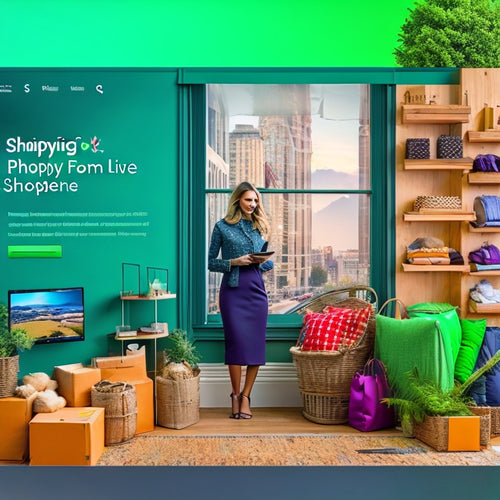
Shipping Labels Unveiled: From Creation to Printing
Share
You rely on shipping labels to guarantee your packages reach their destinations safely and efficiently. From creation to printing, a shipping label's role is essential. You design it to specify contents, provide necessary information, and enable tracking. With customization options, you can tailor labels to fit your business needs. A well-designed label includes a distinctive barcode, sender and recipient details, and service level information. Now that you've got the basics covered, you're ready to explore the finer details of label templates, formats, and printing essentials that can make all the difference in your shipping process.
Key Takeaways
• A shipping label's primary purpose is to provide essential information for inspection and ensure the package reaches its destination safely and efficiently.
• Barcode and tracking information on the label enable real-time monitoring and location updates, streamlining the shipping process.
• Adhering to carrier requirements and industry formatting standards is crucial for creating accurate and scannable shipping labels that prevent errors and delays.
• High-quality printing techniques and correct label placement on the package are vital for ensuring clear, scannable text and barcodes that facilitate smooth delivery.
• Customization options for shipping labels allow businesses to tailor them to their needs, enhancing customer satisfaction and reducing costs while maintaining compliance with regulations.
Understanding Shipping Labels
When preparing a shipment, you affix a shipping label to the container, carton, or box, which serves as an identification label that specifies the contents of the shipping container and contains essential information for inspection.
This label isn't just a pretty face; it's a critical document that ensures your package reaches its destination safely and efficiently.
With label customization options, you can tailor the label to fit your specific shipping needs. But don't get too creative - remember to follow label inspection guidelines to avoid any hiccups during transit.
By including the right information, you'll be able to track your package with ease and impress the inspectors with your attention to detail.
Label Functionality and Design
Your shipping label displays origin and destination information, making your orders legitimate and trackable, thanks to specific templates that incorporate barcodes, numbers, and letters for detailed shipping information. With label customization, you can tailor your labels to fit your business needs, ensuring efficient tracking and delivery.
| Label Element | Purpose |
|---|---|
| Barcode | Unique identifier for tracking |
| Sender's Details | Originating address and contact info |
| Recipient's Details | Destination address and contact info |
| Tracking Info | Real-time updates on package location |
| Service Level | Priority or expedited shipping options |
Benefits and Best Practices
By incorporating shipping labels into your logistics process, you can reap several benefits that enhance customer satisfaction, reduce costs, and streamline your operations.
One major perk is label customization, which allows you to tailor your labels to fit your brand's unique needs.
Additionally, shipping labels ensure compliance with regulations, saving you from potential penalties and fines.
By using accurate and scannable labels, you can also reduce errors and delays, resulting in faster delivery times and happier customers.
To get the most out of your shipping labels, make sure to follow best practices like accurate labeling, clear formatting, and inclusion of essential details like tracking info and service levels.
Label Templates and Formats
Carriers and eCommerce companies depend on specific label templates to aid in tracking orders, maintaining smooth communication throughout the supply chain process. These templates are crafted to meet industry norms, catering to carrier prerequisites and tracking technology. You'll observe that customization choices are available to match your business requirements, but it's crucial to follow the guidelines.
Here are some key aspects to take into account when working with label templates and formats:
- Adherence to carrier requirements: Make sure your labels meet the specific requirements of carriers like USPS, UPS, or FedEx.
- Standardized industry formatting: Utilize standardized templates to prevent errors and delays.
- Tailored options for customization: Adjust your labels to suit your business needs, while still adhering to regulations.
- Integration of tracking technology: Include barcodes, QR codes, or RFID tags to streamline tracking and monitoring.
Printing and Placement Essentials
Once you've selected the ideal label template, it's time to focus on printing and placing the shipping labels correctly to guarantee smooth communication throughout the supply chain.
When it comes to printing, you'll want to use high-quality printing techniques that secure clear, scannable text and barcodes. Avoid using low-resolution printers or faded ink, as this can lead to errors and delays.
Now, let's talk label positioning. Place your shipping label on the largest side of the package, making sure it's firmly affixed to prevent damage and secure readability. Remember, incorrect label placement can cause confusion and misrouting, so double-check your work!
Frequently Asked Questions
Can I Create a Shipping Label Without a Carrier Account?
You're like a master chef, whipping up a shipping label without a carrier account - it's possible! You can use online platforms offering label customization options or explore alternative label printing services, like Stamps.com or PayPal Shipping, to cook up a label that suits your needs.
How Do I Handle Shipping Label Errors or Misprints?
When handling shipping label errors or misprints, you'll need to correct mistakes quickly, process refunds if necessary, and reprint accurate labels to prevent delays, ensuring a smooth customer experience and avoiding logistical headaches.
Are Shipping Labels Required for International Shipments?
When shipping internationally, you'll need to guarantee compliance with customs requirements, so yes, shipping labels are required. You'll have various label printing options, including integrated labels with customs forms, making it easier to navigate complex regulations.
Can I Reuse Shipping Labels for Multiple Packages?
"You shouldn't reuse shipping labels for multiple packages, as it compromises package tracking and label recycling efforts, opting for cost-effective, sustainable options instead, like printing new labels for each package, ensuring smooth delivery and a clear conscience."
Do Shipping Labels Expire or Have a Limited Usage Period?
You're probably wondering, did you know that 1 in 5 packages are lost or delayed due to incorrect labeling? Now, about those shipping labels - they don't expire, but they do have a limited usage period, usually 3-6 months, depending on the carrier's label expiration policies.
Related Posts
-

How Do I Customize My Search Results on Shopify
This article aims to provide an informative overview of the process of customizing search results on the Shopify pla...
-

Does Shopify Have Live Shopping
This article explores the presence of live shopping on the Shopify platform. It aims to provide an objective analysi...

